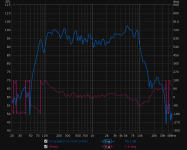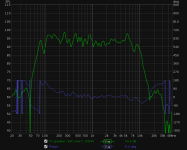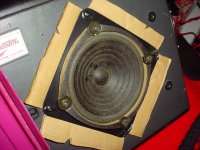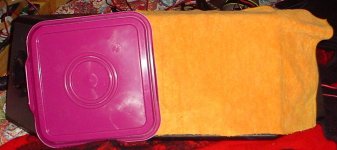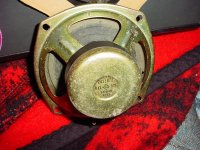I recently started experimenting with this old driver I had sitting around. Despite what can be said about it, it seems intelligently designed for it's application.
This is not to make specious arguments about this being a Hi-Fi driver. I am just a bit surprised and interested in the engineering of this driver because it is good enough that, if I had such a TV when I was a child I know I would have had fond memories of it. The response seems to be perfect to equalize out when it is covered with cloth (a microfiber towel in this case). It's true there are 5.4k and 8.8k peaks, but they are outside the really bothersome range.
These measurements were taken with a small series inductor which improves the response a bit, but does not really change my point.
First image is raw response, second image is with cloth. 3rd image is the speaker crossed with a tweeter from one of my Dayton B652-Airs.
This is not to make specious arguments about this being a Hi-Fi driver. I am just a bit surprised and interested in the engineering of this driver because it is good enough that, if I had such a TV when I was a child I know I would have had fond memories of it. The response seems to be perfect to equalize out when it is covered with cloth (a microfiber towel in this case). It's true there are 5.4k and 8.8k peaks, but they are outside the really bothersome range.
These measurements were taken with a small series inductor which improves the response a bit, but does not really change my point.
First image is raw response, second image is with cloth. 3rd image is the speaker crossed with a tweeter from one of my Dayton B652-Airs.
Attachments
It looks really good on a 120dB scale. 😉 Seems to be a nice wide midrage driver that covers just about all you need for speech and dialog.
True, but the major grid is 5db which is the important part for me to see variations to scale. With the AMT, almost the whole response falls within a 5db band which means +-2.5db response variation, which is the point where I really have to begin looking at off-axis response to figure out why it still doesn't sound right. 😉
However being a 4.5" cone it seems to have better dispersion in the lower midrange which seems to sound better in general than 6" cones.
However being a 4.5" cone it seems to have better dispersion in the lower midrange which seems to sound better in general than 6" cones.
Yep, it's foam. I have 2. Many years ago when I got them the foam on the other one was disintegrating so I "repaired" it with super glue which shriveled the surround, then duct tape and wiped boiled linseed oil on the cone. Added some walnut oil later out of sheer cantankerousness. Eventually I treated the other to match but I could never tell there was any difference by ear or by measurements. Yes, I have a colorful past...
I would not compare it to the diatone in any way other than appearance. The Diatone did not have the huge boost above 2KHz and that indicates the two cones respond to breakup in completely different ways. The forgiving explanation is that the designer intended this speaker to be used behind cloth and so the rise in response after breakup was an advantage.
I've looked but can't find a surround of a size that would fit, and wouldn't know how to dissolve the glue to get the old surround off.
I would not compare it to the diatone in any way other than appearance. The Diatone did not have the huge boost above 2KHz and that indicates the two cones respond to breakup in completely different ways. The forgiving explanation is that the designer intended this speaker to be used behind cloth and so the rise in response after breakup was an advantage.
I've looked but can't find a surround of a size that would fit, and wouldn't know how to dissolve the glue to get the old surround off.
This guy used foam in front of his speaker for a similar effect:
http://twisterspeakers.blogspot.com/2010/12/neo8-pdr-in-waveguide.html
http://twisterspeakers.blogspot.com/2010/12/neo8-pdr-in-waveguide.html
you beat me to that comment freddi :^) My first thot when i saw it.... and its cone "Diatone-ish"
dave
The frequency response of this speaker resembles the response of the Scan-speak Revelator series. 18w8531g00:

It seems like they could use some cone edge damping to remove the kink at 800Hz, but speaker designers seem to be in the habit of using this feature in speakers to compensate for the baffle step peak.
It seems like they could use some cone edge damping to remove the kink at 800Hz, but speaker designers seem to be in the habit of using this feature in speakers to compensate for the baffle step peak.
- Home
- Loudspeakers
- Full Range
- Interesting console TV driver, design for application
